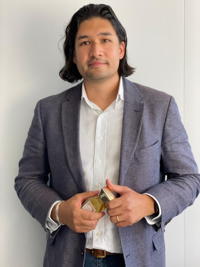
Jérôme Lesquendieu
Founded in 1903, Maison Lesquendieu owes its international success in the early 1900s to the unfailing demanding nature of pharmacist and perfumer Joseph Lesquendieu, who was only content with exceptional compositions based on first-choice raw materials.
“My grandfather was anxious to stick to a small production. To him, no one could produce a lot without failing somewhere. There was a limit not to be exceeded to keep control of quality, from sourcing to the finished product. At that time, the brand developed in over 20 countries in ten years,” explains Jérôme Lesquendieu.
This product-oriented hyper luxury spirit made the brand highly successful up until its heyday, in the 1960s. Today, it is coming back thanks to Jérôme Lesquendieu’s determination to offer the perfume world extreme refinement again, down to the smallest detail.
“I had this feeling there was no such brand reminding of the 1920s in the perfume world, unlike in the luxury aviation or car industries: there was no segment where people ‘made the effort of excellence for something unnecessary’”, he says.
A hundred-year-old French family brand
To reach his target, the new Director was anxious to keep his grandfather’s original method: he refused any tolerance to imperfections and preserved manual work to make small volumes.
By immersing himself in the perfumer’s archives, he revived five of the creations that best evoked Lesquendieu’s journey throughout the 20th century.
Of course, the first “Historic” perfume is the very first fragrance created in 1903, Lesquendieu Le Parfum. “My grandfather was the son of a tanner, so there are leather notes, but also bergamot and jasmine notes. It is a particularly mysterious and sensual creation,” explains Jérôme Lesquendieu.
Then, there are Feu de Bengale, created in 1925 and based on Madagascar vanilla, and Bonne Fortune, a 1927 fresh citrus-based perfume ending with warm notes: “it is the fragrance he wore the most,” adds the Director. These are followed by Glorilis, a powerful spicy oriental perfume which dates back to 1953, and lastly, Lilice. “My grandfather created this fragrance for my grandmother he called Lilice – only for his own personal use. I made this choice for the story it tells. It is a mixture of iris and rose, two fascinating materials complex to work with and balance.”
Almost fully composed of natural materials, the juices boast a concentration of over 20% and last all day, as the original fragrances did.
The bottles have the same bell shape as in the 1920s and display a few codes of that period. They are now decorated with a handmade pure 24-carat gold cap.
A contemporary collection
Under Artistic Director Jérôme Lesquendieu, a new collection of five Oriental fragrances was recently launched in Dubai before being distributed in Europe in September. “It is a completely different range which I directed based on my grandfather’s travels to the Middle East,” he explains.
Maison Lesquendieu counts over 50 points of sale in Europe – Jovoy in France, the Four Seasons in Geneva, Switzerland – and in the Middle East. It keeps expanding on the global level, in particular in Asia, Russia, the UK, and Eastern countries.
The fragrances are available for about 240 euros for the Historic range and 280 euros for the Oriental Collection.
Source link : https://www.premiumbeautynews.com/en/maison-lesquendieu-revives-their,18936












